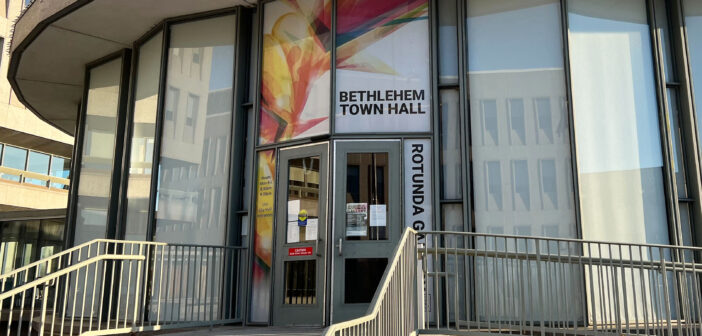Members of the Bethlehem community, the city’s Community Development Committee and City Council convened at Town Hall Tuesday to discuss Bethlehem’s Comprehensive Housing Strategy and the 2023 Strategic Plan to Address Homelessness, titled “Opening Doors.”
To further the Sept. 26 meeting’s conversation about the first part of the plan, the creation of a permanent homeless shelter in Bethlehem, part two of the committee presentation focused on recently acquired data and programmatic recommendations within five strategy areas.
These recommendations were proposed by multiple members of Bethlehem city government, including Mayor J. William Reynolds; Laura Collins, director of community and economic development; and Sara Satullo, deputy director of community development.
2023 Housing Study data
Bethlehem’s housing market has changed rapidly since 2019. According to the presentation, the median sales price of houses has increased from $182,000 in May 2019 to $302,000 in May 2023, and median rent increased from $1,353 in May 2019 to $1,910 in May 2023.
“This rise in prices is creating substantial pressure for many of our residents who may now find it incredibly difficult to stay in the city, given the current housing costs,” Satullo said.
For housing to be qualified as affordable, its price cannot exceed 30% of a household’s income, and extreme cost burden is quantified as paying more than 50% of household income on housing, according to the presentation.
Collins said there are 8,300 low-income households that are cost-burdened in Bethlehem.
“If you’re already spending more than 50% of your income on housing, a medical bill or a car repair or something like that could very quickly propel you into homelessness,” Collins said.
The median household income in Bethlehem is $62,146 a year, according to the presentation, and the median house sales price is about $300,000.
Even for those who can afford a $300,000-average home or affordably rent a one-bedroom apartment, Reynolds said the supply is not there.
Increasing ease and financial feasibility of building new affordable housing units
Collins said the city needs to alter zoning ordinances and infill development to incentivize affordable housing development in Bethlehem.
She said financing is necessary to create a variety of affordable housing projects, and the city plans on gap financing — short-term loans that meet immediate financial obligations.
Increasing middle housing — housing types that fall somewhere in between single-family homes and mid-rise apartment buildings — is another recommendation the city has, according to the presentation.
According to Local Housing Solutions, middle housing can help increase the availability of less expensive housing types and support vibrant, walkable neighborhoods, while gently increasing population density.
Collins said this creates a healthy mixed-income community with strong public schools and a sense of cohesion.
Reynolds said people have traditionally supported the idea that everyone should live in a neighborhood that has all similar housing types. He said this has influenced zoning ordinances in the past, thus limiting middle housing development, and increasing middle housing often comes with pushback.
“This is not without controversy to some people,” Reynolds said. “And it is a test for those of us in decision-making places about whether or not we would support that type of change in zoning that would change the way some people think about what their neighborhood is.”
Satullo said the committee wants to implement “gentle increases in density” through the creation of a program that allows Accessory Dwelling Units in targeted neighborhoods.
Current zoning ordinances do not allow the construction of ADUs, so Collins said these would require ordinance updates.
“As part of the pilot program, we would be designating areas and targeting types of units and setting whether or not there would be affordability requirements associated with the program,” Satullo said. “And ADUs allow you to gently increase neighborhood density and also increase opportunities for scattered-site development throughout a city.”
Renovating alley houses — a historic housing type in Bethlehem — would also gently increase neighborhood density.
Satullo said the city has been working for the last few months with Lehigh University and Community Action Lehigh Valley on a program to usher in the revival of these properties and make them affordable housing units. She said while the city works through the zoning updates for ADUs more generally, Lehigh students are seeking funding for an alley house project.
Creating Incentives and Partnerships
Collins said the lack of available land in the city of Bethlehem is one major barrier when doing projects of these sizes, especially in a market that is of interest to private developers.
She said there is a lot of competition, so the committee has to work with partners and identity developers who are interested in affordable housing projects, while also making it financially feasible.
She said they ultimately hope to create some sort of Request For Proposal or application process for developers who want to work on a project but don’t have the financial means to do so, but it would not be a grant program.
Collins said the committee recommends a partnership with the Bethlehem Housing Authority for a landlord incentive program — providing incentives for property owners to rent to low-income families and individuals.
Satullo said the authority has about 100 unused Housing Choice Vouchers out of a total of 476.
According to the U.S. Department of Housing and Urban Development, these Section 8 vouchers are “the federal government’s major program for assisting very low-income families, the elderly, and the disabled to afford decent, safe, and sanitary housing in the private market.”
Collins said landlords used to consider these vouchers as stable income and would collect them, but there is now too large of a gap between the value of the voucher and the market rate rent.
According to the presentation, the U.S. Department of Housing and Urban Development rental reimbursement of $1,000 to $1,500 “lags behind actual rental rates, diluting the power of the voucher.”
“We need to work in concert with the housing authority to create an incentive program for landlords that adds a little bit of additional money to the voucher to make those vouchers attractive to landlords and put those people who qualify for the housing choice vouchers into already available, generally naturally affordable housing units,” Collins said.
Working with partners, the committee also plans to lead a Choice Neighborhoods Transformation plan with a two-year Choice Neighborhoods Planning grant awarded in September 2023.
Satullo said Choice wants a new mixed-income development, and according to the presentation, it is projected to include 400 to 600 units.
Helping low-income tenants stay in their homes
Satullo said recommendations to help low-income individuals and families stay in their homes is basically homelessness mitigation.
According to the presentation, the committee will continue to invest in their housing rehabilitation program and first-time homebuyer’s program.
Satullo said a huge need the 2023 housing study noted evictions have been growing with the expiration of the emergency rental assistance, so the committee wants to help with eviction prevention and rental assistance.
“We have been talking very extensively with both New Bethany and North Penn as part of the PRO Housing grant application to map out what these programs could look like,” Satullo said.
She said New Bethany administered over $11 million in emergency rental assistance over the course of the pandemic, helping thousands of households, so they’ve learned a lot of lessons about how they would want to help the committee structure rental assistance programs going forward.
New Penn has been piloting an eviction diversion program working with New Bethany in South Bethlehem and Lehigh County Court, where they have identified it as being one of the highest-volume courts for evictions.
“One day a week they have a lawyer and a paralegal with a bilingual team who sets up in the courtroom, and they’re doing all of the eviction cases that day and offering mediation and negotiating pay-to-stay agreements to keep people in their housing,” Satullo said.
Advocating for policy change and regional planning
Collins said advocacy starts regionally, and it’s important Bethlehem, Easton and Allentown work together.
She said the three-city coalition is one example of this, as the mayors of Allentown, Bethlehem and Easton are joining together to understand what needs to be advocated for at the state and federal level.
According to the presentation, the cities are limited in their abilities to mandate housing development, stop landlords from raising rent, require mediation proceedings before evictions, and demand townships and suburbs to allow for more density of multi-family housing.
But if the cities collaborate, Collins said they can have conversations about these issues and advocate for development to address housing issues across the region.
“We’re putting ourselves in a better position, not just to help people in Bethlehem but really to kind of tackle the issue more broadly,” Collins said.






Comment policy
Comments posted to The Brown and White website are reviewed by a moderator before being approved. Incendiary speech or harassing language, including comments targeted at individuals, may be deemed unacceptable and not published. Spam and other soliciting will also be declined.
The Brown and White also reserves the right to not publish entirely anonymous comments.